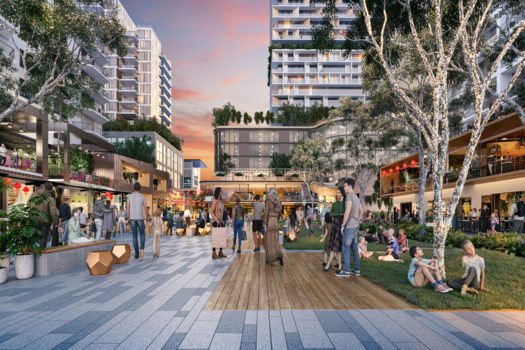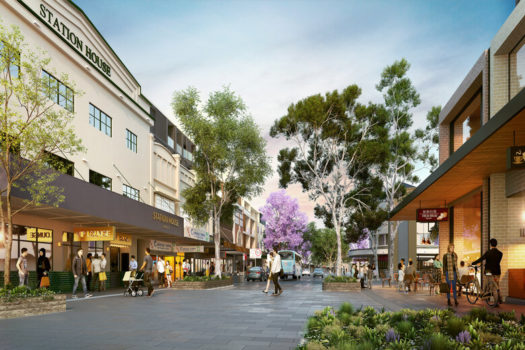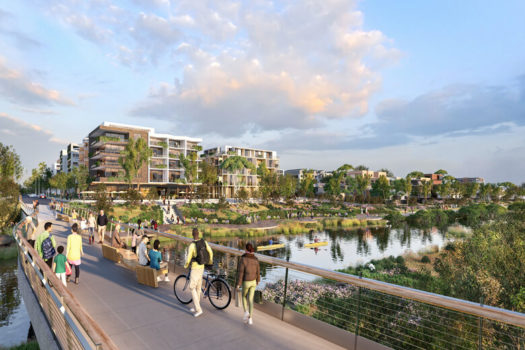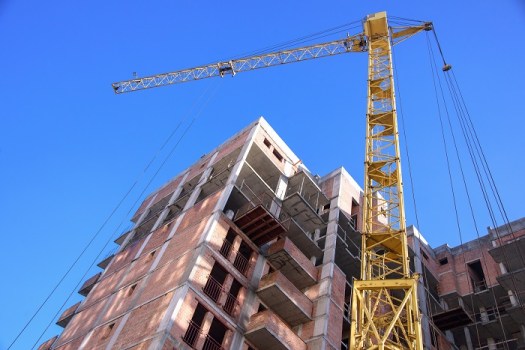
The secret to successful planning is to focus on steering growth rather than responding to it, says City of Canterbury Bankstown planning manager Simon Manoski.

This is exactly what the populous and rapidly growing Sydney LGA aimed to do in its ambitious Campsie and Bankstown masterplans, which were recently recognised at the Greater Sydney Commission’s 2021 Planning Awards.
The awards, announced on June 23, recognise city-shaping ideas, placemaking, excellence in development and community engagement.
The panel selected Canterbury as winner of the ‘planning for jobs and skills’ category for its “inclusive and thorough approach” and for understanding that planning for jobs involves more than just rezoning of land.
Mr Manoski says the plans, underpinned by an economic and night time economy strategy, aim to boost business, jobs, sustainable buildings, affordable homes, culture, open spaces and access to the Sydney CBD.
They include a university campus, a new hospital, a rail metro and facelifts for the town centres.
The plans also acknowledges that Canterbury Bankstown is the most populous local government area in Sydney with half a million people expected to be living in the City by 2036.
“We would rather be on the front foot with our planning and guide that growth as opposed to be responding to that growth,” Mr Manoski told Government News.
“Every city has different needs and wants and the community has different needs and wants, and we thought really hard about what our community needs.
“We’ve really tailored a solution to each of those questions. We didn’t just want an ordinary plan that sits on a shelf – we wanted something we could be proud of.”

Beyond ‘pure planning’
Mr Manoski says the aim was to prepare a strategy outside the box of ‘pure planning’.
“We’re a fast growing city and we’ve want to plan for that growing city, we want to know how our economy will grow and what it will look like over the next 20-30 years ,” he told Government News.
“It’s really about creating a place but we’re made up so many communities so it’s not a one size fits all approach.”
Bankstown is envisaged as the primary commercial centre with a focus on jobs, economics and private investment and a target to become carbon neutral by 2050.
Planning includes major infrastructure investments in a new Sydney Metro Station, the Western Sydney University vertical campus and a $1.3 billion hospital and capacity to accommodate up to 25,000 jobs, 25,000 students and 12,500 new dwellings by 2036.
Every community’s very different and they use the city differently as well so we’ve gone on a really broad engagement process
Simon Manoski
The vision for Campsie is to turn it into a lifestyle and cultural hub on the banks of the Cooks River with an emphasis on culture, open spaces and heritage.
While focus in Bankstown as the city’s key strategic centre is on jobs, in Campsie it’s a more nuanced approach, Mr Manoski says.
“It’s really about community culture,” he says. “Keeping the high street a high street, setting development back off the high street, and creating open public space anywhere we can, big or small.”

Community engagement
Mr Manoski says his team attempted to engage the community throughout the drafting process.
“Every community’s very different and they use the city differently as well so we’ve gone on a really broad engagement process talking to the community, to businesses to agencies, to school kids, the ethnic community, to try and draw out what they’re needs are as well,” he says.
“We want it to be easy and safe to come to work, we want it to be inviting for people to get around. We’re adopting more sustainable standards for our buildings, how they’re built and how they’ll operate into the future.
“The core thing was we really want to get these two centres right, they’re our two biggest centres in the city. And its the model we want to roll out for our other centres across the city as well.”
Planning for the night time economy was also important, Mr Manoski says.
“Generally, authorities plan for cities in the daytime. But what will the night time economy look like?” he says. “We turned our mind to how does the city operate at night time in terms of being safe to get around and activity.”
Corruption probe
In terms of planning and development, there have been some hard lessons along the way, Mr Manoski admits.
Soon after being created via forced merger in May 2016, Council found itself at the centre of a corruption probe sparked by a 2015 complaint and about dubious behaviour by former Canterbury City councillors relating to planning processes and applications.
We pride ourselves on the integrity of our process systems that we have now and we’re trying to be a sector leader for local government on how you assess development.
Simon Manoski
In March this year the ICAC made a finding of corruption against former councillors and staff and recommended tighter planning safeguards across the state.
Mr Manoski, who was called to give evidence during the hearings but was not implicated in any corrupt activity, says Council has since reviewed its processes, undergone internal audits and revised and updated its development assessment framework.
“All the recommendations that the ICAC review put forward we had already put in place before the recommendations came, out so we pride ourselves on the integrity of our process systems that we have now and we’re trying to be a sector leader for local government on how you assess development,” he told Government News.
Mr Manoski says after amalgamation Council also recast its plans for the City and restructured the strategic planning team so it was a stand-alone entity focussed on developing the master plans.

Next steps
Submissions on the master plans have now closed and submissions are being assessed, with plans to have a final proposal ready to go to Council by the end of the year.
As with any development proposal, there have been mixed responses, Mr Maloski says.
We’re saying, look we will grow regardless of any planning and we’ would rather be on the front foot.
Simon Manoski
“While there’s some reticence around the scale of development, there’s been a lot of support to environmental initiatives including mandatory solar roof panels and gas-only buildings,” he said.
He says key challenges for the planning team, as is often the case for any growth area, include accommodating traffic and managing pushback around the amount of development.
“That’s a challenge we need to put to our community,” he says. “We’re saying, look we will grow regardless of any planning and we’ would rather be on the front foot.
“That narrative is always challenging, but we’ve always said to Council we will not put forward a master plan to the community without the required infrastructure to support the growth.
“We done that alongside the masterplans so we can say, ‘here’s the growth, here’s how it’s going to be delivered on time and here’s the infrastructure to support it and here’s how that infrastructure will be paid for over time.”
Council should be ready to start accepting development proposals from next year, Mr Manoski says..
Comment below to have your say on this story.
If you have a news story or tip-off, get in touch at editorial@governmentnews.com.au.
Sign up to the Government News newsletter


